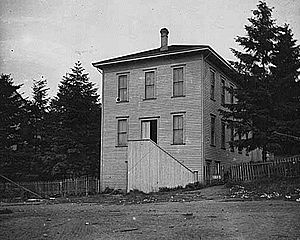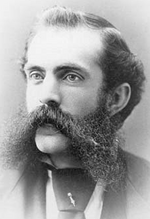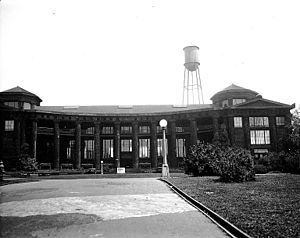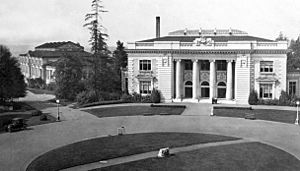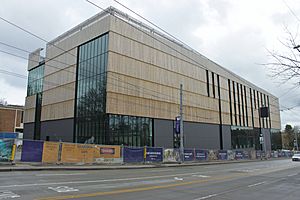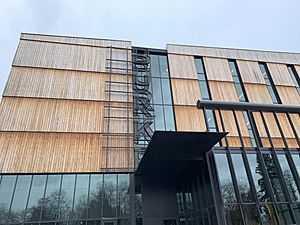Burke Museum of Natural History and Culture facts for kids
 |
|
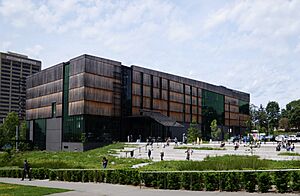
The outside of the Burke Museum
|
|
| Established | 1899 |
|---|---|
| Location | 4303 Memorial Way Northeast, Seattle, Washington, United States |
| Type | Natural history museum |
| Accreditation | American Alliance of Museums |
| Collection size | 16 million |
| Visitors | 104,000 (2017) |
| Owner | University of Washington College of Arts and Sciences |
The Burke Museum of Natural History and Culture, often called the Burke Museum, is a natural history museum at the University of Washington in Seattle, Washington. A natural history museum is a place that collects and displays objects from nature and human history. The Burke Museum is part of the university's College of Arts and Sciences.
The museum started in 1899 as the Washington State Museum. Its story began even earlier, with a nature club started by high school students in 1879. Today, the Burke is the oldest museum in Washington state. It holds a huge collection of over 16 million items, including the world's largest collection of spread bird wings. It is the official state museum of Washington.
Contents
History of the Museum
A Club for Young Naturalists
The Burke Museum's story starts with a group of high school students who loved nature. In December 1879, students Edmond S. Meany, J. O. Young, P. Brooks Randolph, and Charles Denny started a natural history club. Charles's father, Arthur A. Denny, was one of Seattle's founders and helped the club meet at the university. The group officially called themselves the "Young Naturalists Society."
In 1882, a biology teacher named Orson "Bug" Johnson came to the University of Washington. He brought his own collection of 20,000 animal specimens with him. Mr. Johnson joined the Young Naturalists, and his collection made theirs the largest in the Pacific Northwest.
The club's collection of natural objects and historical artifacts grew quickly. At first, they were stored in a backroom of the Denny family's home. In 1886, the club raised money to build a small clubhouse on the university campus to hold everything. University teachers often borrowed items from the collection for their classes.
By the 1890s, the club's collection had grown to more than 60,000 items.
Becoming the Washington State Museum
In 1895, the University of Washington moved to its current location. The part of the Young Naturalists' collection used for teaching moved with it into a building called Denny Hall. In 1899, the Washington State Legislature (the state's law-making group) officially named this collection the Washington State Museum. A few years later, in 1904, the Young Naturalists Society donated the rest of their collection to the new museum and the club ended.
Moving from Building to Building
The museum moved several times over the next few decades. After a big fair called the Alaska–Yukon–Pacific Exposition in 1909, the museum moved into one of the fair's empty buildings.
Unfortunately, that building had a leaky roof. So, the museum moved to another fair building, the old Forestry Building. But they soon discovered it was filled with bark beetles! From 1923 to 1927, the museum's collections had to be scattered in different places around the campus.
Finally, in 1927, the museum moved into the Washington State Building, which was also built for the 1909 fair. It stayed there for 30 years.
A New Name and a New Home
In 1957, the museum's building was declared unsafe and had to be closed. Around the same time, the museum received a gift from the family of Thomas Burke, an important figure in Seattle's history. His wife, Caroline McGilvra Burke, wanted to create a memorial for her husband.
She left her own collection of Native American artifacts to the museum. The Burke family also offered money to help build a new museum building, but with one condition: it had to be named after Thomas Burke. The new Burke Museum opened on May 3, 1964.
By the 2010s, the museum needed an even bigger and more modern home. In 2014, it began raising money for a new building. Construction finished in 2018, and the old building was closed. It took a whole year to move all 16 million items to the new location.
The new, $106 million Burke Museum opened to the public on October 12, 2019. It was designed by architect Tom Kundig. The new building has large windows that let visitors see into the research labs and storage areas. This means people can see parts of the collection that were once hidden away. The museum also has a garden with native Washington plants and a café that serves Native American cuisine.
What's in the Museum's Collections?
The Burke Museum has over 16 million artifacts and specimens. These are divided into three main areas: anthropology (the study of human cultures), biology (the study of living things), and geology (the study of the Earth).
- Biology: The museum has the world's largest collection of spread bird wings. It also has the second-largest collection of frozen bird tissues, which scientists use for research. The mammal collection has over 55,000 specimens, making it one of the largest in North America.
- Anthropology: The museum's collection of art and artifacts from Native American cultures of the Pacific Northwest is the fifth-largest in the world. It includes thousands of objects, from historical carvings to modern art prints and sculptures.
Museum Exhibits
Past Exhibits
Before the museum moved in 2018, it had three main exhibits.
- "Life and Times of Washington State" showed 545 million years of the region's natural history. It had huge fossils, like a skeleton of an Allosaurus and a giant ground sloth that was found when Seattle-Tacoma International Airport was being built.
- "Pacific Voices" shared the stories and traditions of 19 different Native American and Pacific Rim cultures through their art and objects.
Current Exhibits
When the new museum opened in 2019, it introduced several new galleries for visitors to explore.
- Culture is Living: Here, you can see objects from Pacific cultures and hear stories from people in those communities today.
- Northwest Native Art: This gallery showcases amazing art from the indigenous peoples of the region.
- Amazing Life: This exhibit explores the diversity of life on Earth.
- Our Material World: This gallery looks at the natural materials that make up our planet.
- Fossils Uncovered: This popular exhibit features one of the best-preserved Tyrannosaurus rex skulls ever found, along with many other fossils.
The museum also has a gallery for temporary exhibits that change throughout the year.
How the Museum is Run
The Burke Museum is part of the University of Washington College of Arts and Sciences. A group called the Burke Museum Association (BMA) helps support the museum by raising money and connecting with the community.
The museum gets its funding from several places. About half comes from the state of Washington. The rest comes from grants, donations from people and foundations, and money from ticket and gift shop sales.


